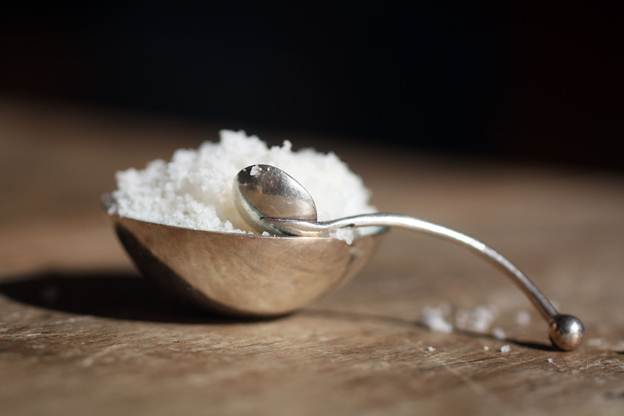The weight-loss pariah has hampered your
efforts for too long. It’s time to crack down on salt…
We tend to point the finger at fat and
sugar when it comes to diet demons. But there’s another, sneakier ingredient
that’s often ignored. It has no calories, and it’s packed with important
minerals we all need. We’re taught to add it at every meal and it’s often found
lurking in everyday foods. Yep, salt – that innocent white crystal that makes
caramel taste amazing and can help mask a multitude of cooking sins – is
probably the reason your favorite jeans are still that little bit too snug.

Water weight
Salt may not carry any calories, but it can
be responsible for you piling on the pounds through water retention. Not sure
what we’re talking about? It’s that puffy look you wake up with the morning
after you’ve scoffed that deliciously salty takeaway pizza (if your raging
thirst hasn’t already woken you up at 3am, that is). It’s not pretty – and it
could really be scuppering your weight-loss plans.
Of course, if it’s a one-off, the puffiness
will naturally go down when your body eliminates the excess salt through urine,
but if your diet is high in sodium (which can happen without you even realizing
it), water retention can become chronic. If you’re on a diet, your results will
plateau. And if you aren’t, you’re likely to continue feeling a little
uncomfortable.
Eating too much salt causes the body to
attempt to restore its balance by drawing water into the blood to dilute the
sodium. You can feel this happening when you get thirsty after eating peanuts
or crisps. Water then flows into other areas, such as the skin, making us look
and feel fatter.
Know your enemy
The thing is, we all need salt. It’s made
up of sodium chloride and we need sodium, along with potassium, to help carry
the electrical impulses that control our bodily functions. So there’s no doubt
that it’s important! But, we need the right ratio of sodium to potassium
for these chemical reactions to work properly.
The Government recommends a maximum of 6g
salt per day, or 2.4g of sodium. This is because too much sodium causes high
blood pressure (which can lead to an increased risk of heart disease) and
strains the kidneys. Salt also damages the brain and a high salt intake is
linked to vascular dementia – your arteries to the brain become blocked, which
can lead to a stroke. Still reaching for the salt shaker now?
Hidden pounds
The science is hard to argue with, so why
does the average person in the UK take in around 8.6g of salt per day, nearly
50 per cent above the recommended amount? The main reason is that, unbeknown to
most of us, salt is hidden in a myriad of foods. If your diet isn’t working,
the culprit could be something as seemingly harmless as tomato ketchup – or
stock cubes, gravy granules, sausages, bacon, bread or biscuits – the list is
endless.
So, if you want to get rid of that stubborn
water weight, how do you do it? Here are our top tips for striking the right
sodium balance.
Five easy peasy ways to slash your salt intake

- Spice it up
There’s no doubt that salt peps up a bland
dish, but is that extra inch (or two!) on your waist worth it? Of course not!
Experiment with adding some fresh or dried herbs and spices to your meals
instead. Fresh chilli, garlic and ginger pack of a tasty punch or, for a more
subtle flavor, add in onions, shallots or a squeeze of lemon juice.
- Go DIY
They may be convenient, but ready made
stocks, sauces and soups are often really high in salt. You can make your own
stock from a leftover roast chicken carcass and freeze it in individual
portions. And if you need a quick fix, look out for low sodium vegetable stock
cubes (try the Marigold or Kallo brands). Making your own sauces and soups is
also a healthier – and cheaper – option.
- Eat at home
Restaurant and pub meals can be real
killers when it comes to hidden salt. EAT ham and free range egg sandwich
contains 3.3g salt per portion, over half the recommended daily amount. A
Wetherspoon’s pie and mash meal has, wait for it, 7.5g of salt. Make packed
lunches and invite friends over for dinner instead. It’ll save you money, too!
- Avoid the snacks
Snack foods are probably one of the worst
water-weight culprits. A bag of salt and vinegar crisps has 4g salt: a sachet
of hot chocolate has 5g salt and three digestive biscuits contain 6g salt,
almost as much as a whole packet of peanuts, which has 7g. So, if you’re
hungry, opt for a piece of fruit and some raw, unroasted, unsalted nuts
instead.
- Make friends with potassium
Water retention is caused by an excess of
sodium in relation to potassium, so one way to improve the situation is to
increase your potassium intake. Fruits and vegetables are potassium rich,
especially potatoes and sweet potatoes, asparagus, spinach, cabbage, sprouts,
bananas, tomato sauce (the low-salt version), oranges, apricots and currants.